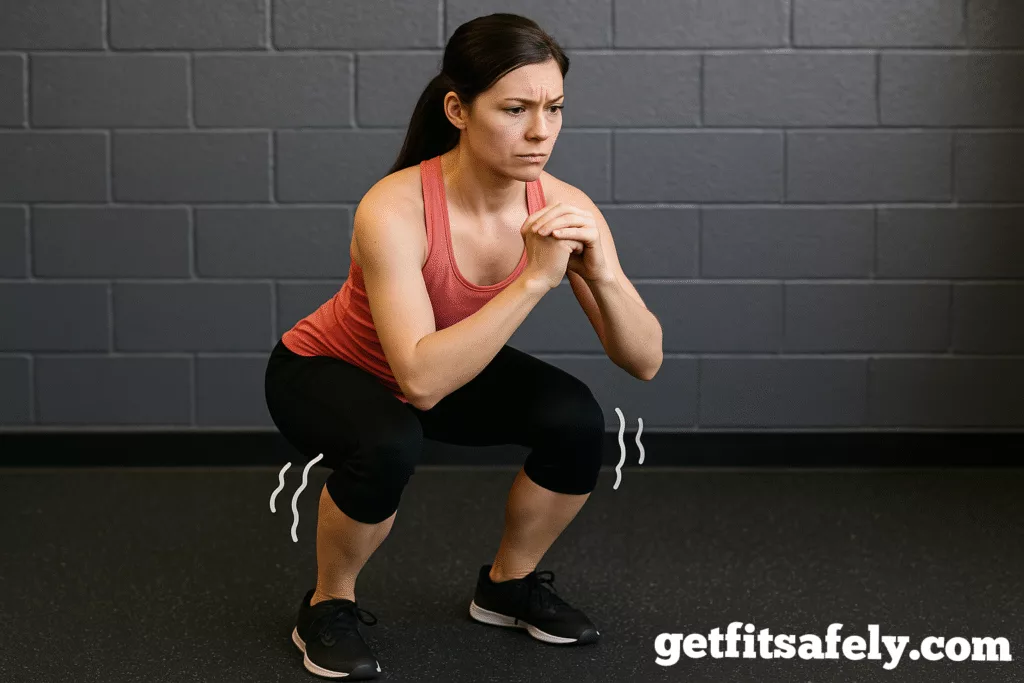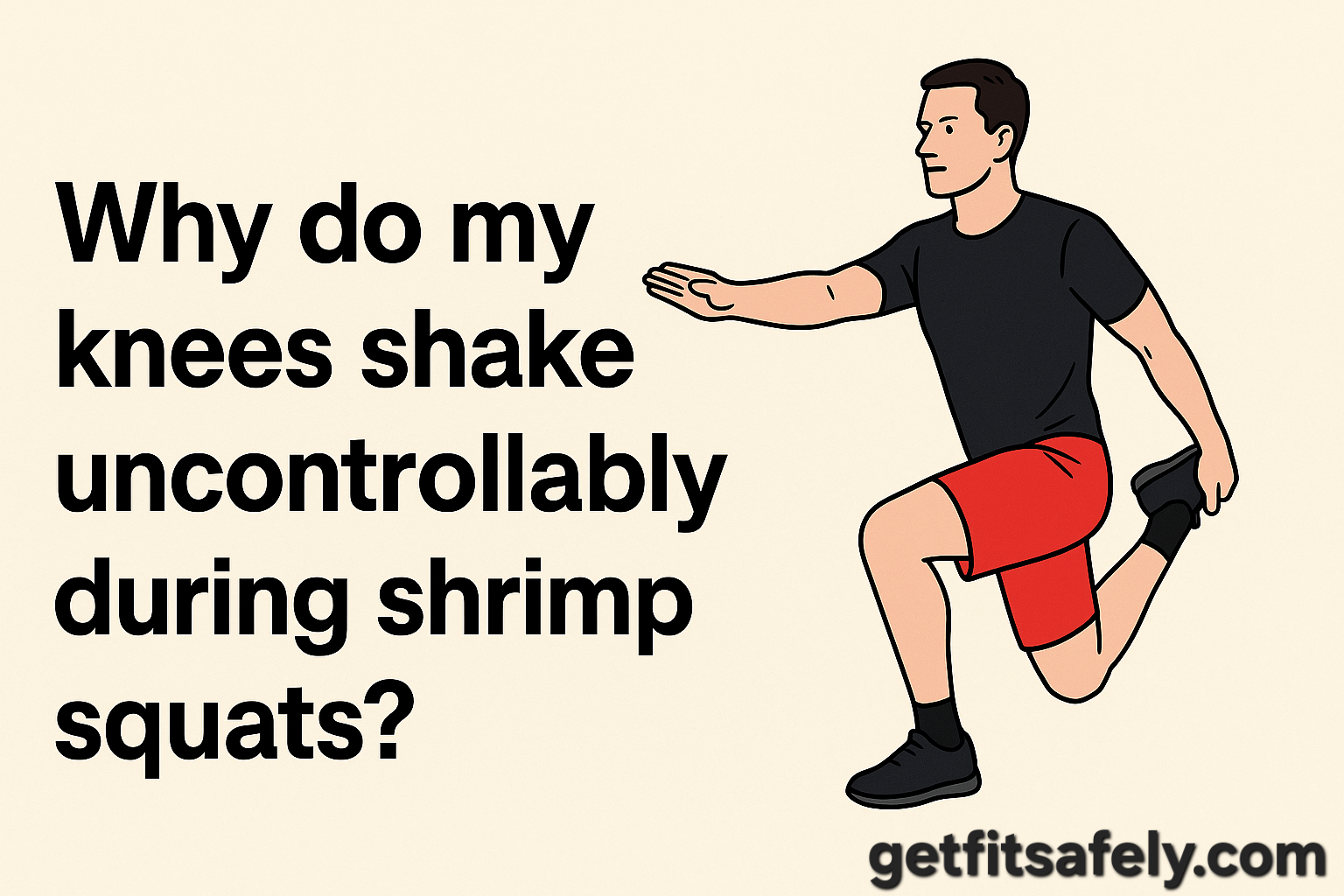So.
If you’re also there, with one leg pulled behind like you’re about to propose to the floor, and suddenly your knees start trembling like they’re trying to communicate with the afterlife…
Welcome to the club.
It’s not a glitch in your body. It’s the shrimp squat itself that’s cursed.
Or rather, challenging. Extreme. Almost unfair.
And no, it doesn’t mean you’re weak, unbalanced, or that you should give up on your dream of steel legs and ninja-level balance.
It just means you’re human.
And you’re attempting one of the most brutal (and underrated) squat variations ever invented on this planet.
But don’t worry, I’m about to explain exactly what’s going on when your knee starts partying like it’s at a rave during the shrimp squat.
What is a shrimp squat really (and why does it humiliate you so badly)?
Picture doing a squat on one leg.
So far, so good. Already tough.
Now picture taking the other leg, bending it backward, and holding it with your hand.
If that sounds like some kind of extreme yoga or Balinese dance pose, you’re getting the vibe.
The shrimp squat is a lethal cocktail of:
- unilateral strength
- micro-precise balance
- hip flexibility
- neuromuscular control
- ankle stability
- and a solid dose of courage
Sounds simple until you actually try it.
Then your body starts sounding the alarm like a nuclear control panel: “Instability! Collapse! Earthquake in the left knee!”
And you get it right away:
There’s no cheating here.
No shortcuts.
If you lack control, power, and coordination… the knees will short-circuit.
Why do your knees shake so much?
Let me tell you right away: the shaking isn’t a sign of weakness.
It’s a signal.
A very visible way for your body to say, “Hey, I’m trying to activate a bunch of small muscles and coordinate the movement, but this stuff is way too advanced for me right now!”
Here are the three main reasons for that earthquake-like trembling:
1. Nervous system overload
The shrimp squat is one of those exercises that momentarily crash your brain-computer. You’re managing:
- balance
- tension
- controlled descending movement
- constant core activation
The brain has to talk to the muscles in real-time and say, “Activate now, no not like that, harder there, less here!”
The result?
Trembling, because the brain-muscle connection starts buffering.
2. Confused proprioceptors
Proprioception is your body’s ability to know where it is in space. Like your internal GPS.
But when you do a shrimp squat, that GPS goes haywire.
Because you’re in a bizarre position, and your body isn’t used to handling such off-balance forces, angles, and levers. So the poor knee tries to compensate for the chaos with little jolts and tremors.
3. Weak stabilizer muscles
You could have massive quads, rock-hard glutes, and a 200 kg deadlift…
But if you haven’t trained your stabilizer muscles like the gluteus medius, deep core, or the small but heroic vastus medialis oblique (VMO)…
Your knee will behave like a scared puppy during its first thunderstorm.
Shaking is its way of saying, “I’m doing my best, but I need to get stronger!”
Spoiler: your ankles are partly to blame
Yep. Those dancing kneecaps aren’t always your legs’ fault.
Sometimes it’s your ankle sabotaging you.
If it’s not mobile or strong enough, the load shifts where it shouldn’t.
And the knee ends up doing a job that isn’t its own.
It’s like in a soccer team: if the goalkeeper starts playing defender, midfielder, and striker… something’s gonna break.
So you need:
- ankle mobility
- active foot contact
- engaged arch of the foot
All things that keep your shrimp squat from turning into a comedy sketch.
Does it hurt? Should I stop?
Absolutely not, unless you feel real joint pain.
Trembling from effort or neuromuscular instability isn’t dangerous.
It’s a signal.
And if you listen closely, it shows you where you’re lacking. Where to work. Where to improve.
But sharp pain (like stabs, collapsing sensations, or knee clicks) is a different story. That’s when you need to stop, regress, and figure out what’s wrong.
How to improve without looking like a melting popsicle
Here are a few tricks to build stability and strength without looking like a lamp post in an earthquake:
- Assisted shrimp squats: use a door, a chair, a pole. Even the bathroom wall if needed.
- Elevated version: instead of going all the way down, start from a step. Lower it gradually.
- Slow eccentrics: descend in 5–8 seconds, then come back up with help from the other leg.
- Isometrics: stop halfway down and hold. If it shakes, you’re doing it right.
- Targeted work on gluteus medius and core: side plank, clamshells, bird dog, Pallof press. Hate them? Perfect, they’re essential.
Even your head shakes a little — and that’s okay
This one’s tough.
But it has to be said.
Sometimes, knee trembling isn’t just physical.
It’s a kind of anticipatory muscle anxiety.
Your body doesn’t fully trust you yet.
Because it knows you might fall.
Or hurt yourself.
Or maybe you’ve never “programmed” that neuromuscular sequence before.
That’s when the trembling becomes a defense mechanism.
I’ve noticed that when I’m distracted or unsure, I shake more.
But when I visualize the movement, focus on every micro-phase, and really trust myself… the body responds with much more stability.
It’s not just strength. It’s neuromuscular trust.
And sadly, you can’t train that on machines.
Only through movement experience.
“But my knees also shake during regular squats… is that normal?”

Absolutely yes.
In fact, if your knees already shake during regular squats — especially after some heavy sets — the shrimp squat will just amplify that tremor like a megaphone.
Why?
Because squat tremors — even with a barbell or bodyweight — often show up when:
- you’ve done high-rep sets
- you’ve accumulated neuromuscular fatigue
- or you’re working close to your technical max
In short, when your nervous system is tired, stabilizer muscles can’t keep everything “tight and aligned” anymore.
And that fatigue… shows up exactly like it does in the shrimp squat: with little shakes, especially at the bottom, when you’re most vulnerable.
And remember, in regular squats you can still compensate with both legs.
But the shrimp squat isolates you on a single leg, with terrible mechanical leverage…
So the shaking becomes as obvious as a flashing siren.
I always say: if you tremble after 4 loaded squat sets, it’s normal.
But if you’re already shaking during warm-up with just your bodyweight… your body’s asking you to strengthen something before loading again.
It’s not a judgment. It’s an opportunity.
To build solid foundations and become a tank — not just a lifting machine.
Watch out for the surface you train on
This sounds like a tiny detail, but it can change everything.
Doing shrimp squats on a slick floor, slippery surface, or with too-soft shoes is like trying to write on wet paper:
You might have perfect handwriting, but it still turns out messy.
My advice?
Use stable shoes or, even better, go barefoot on a rubber surface.
Avoid yoga mats that are too squishy.
And if you want to push further, try a few reps on a balance board for a bigger neurological challenge — but only once you’ve built decent control.
I always do them on hard wood or thin tatami mats: the difference is massive compared to when I used to train in running shoes on a yoga mat.
Do you really need shrimp squats? Or not?
Uncomfortable question, I know.
Because now they’re everywhere: influencers, coaches, mobility challenges.
But here’s the truth — they’re not mandatory.
Are they useful?
Absolutely.
But only if they fit your goals.
Want to become a bodyweight machine?
Calisthenics or parkour athlete?
Trail runner or martial artist?
Then yes, they’re gold.
But if your goal is just hypertrophy or building leg strength in a more traditional way… there are tons of less frustrating, equally effective alternatives.
I use them because I like the challenge.
I like the fact that you can’t fake it: either you’ve got control, or you shake.
It’s a lesson that goes beyond training.
But if they freak you out, hurt you, or stall your progress, there’s no shame in shelving them and building strength another way.
RELATED:》》》Why Do Pistol Squats? 9 Compelling Reasons!
Conclusion
Want the truth?
The trembling is your teacher.
It tells you exactly where to work, what to strengthen, and when you’re ready to level up.
It’s the opposite of the comfort zone.
But it’s also where real transformation happens.
The body learns.
The brain adapts.
The knees stop dancing… and start dominating.
So keep going.
One tremble today,
Total control tomorrow.


